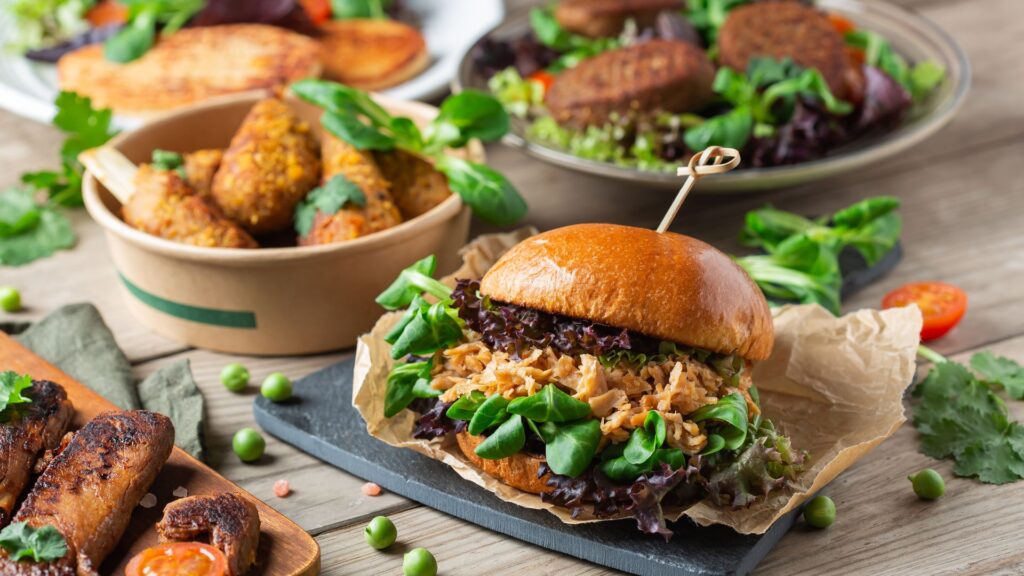Protein is an essential nutrient for human health, serving as the building blocks for body tissues, enzymes, and hormones. Historically, most people have relied on animal-based proteins, but a growing number of people are turning to plants for their protein fixes. Find the diverse world of plant-powered proteins, unravel the mystery of how much protein vegans and vegetarians need, and reveal some creative meal ideas to help you get your daily dose.

Why Plant-Based Protein?
With more people adopting vegan and vegetarian lifestyles, the demand for plant-powered protein sources has risen in recent years. Some potential benefits include reduced environmental impact, improved health outcomes, better weight management, and lower risk of foodborne illnesses when compared to animal-based protein sources. Moreover, plant-based proteins often come with added bonuses like fiber, antioxidants, and essential nutrients that cater to a more well-rounded diet.
Embracing a plant-based diet has also been shown to help reverse heart disease. Switching to a plant based diet reverse heart disease is gaining popularity among those who prioritize their heart health, as it lowers cholesterol levels and reduces the risk of high blood pressure.
Natural Sources and Daily Intake
While plant-based protein sources may not always be as concentrated as their animal counterparts, there are plenty of options to provide ample protein in your diet, such as:
- Legumes: chickpeas, lentils, black beans, kidney beans, and edamame
- Whole grains: quinoa, barley, bulgur, and farro
- Nuts and seeds: almonds, pumpkin seeds, chia seeds, and sunflower seeds
- Tofu, tempeh, and seitan: soy-based or wheat-based protein-packed alternatives
- Vegetables: leafy greens like kale, spinach, and broccoli
The recommended daily protein intake varies based on factors such as age, gender, and activity levels. Generally, the standard rule has been to consume about 0.36 grams of protein per pound of body weight. However, in the case of plant-based diets, aiming for a slightly higher daily intake (0.41 grams per pound) can more effectively provide all the essential amino acids, which are the building blocks of protein, considering plant-based protein sources may have lower digestibility.
Combining Plant-Based Protein Sources
Though some plant-based proteins are considered complete (containing all nine essential amino acids), many are not. To ensure adequate intake, combining complementary protein sources thus becomes essential. Doing so can provide a full spectrum of amino acids in a single meal, and examples include beans and rice, hummus and pita bread, and peanut butter and whole-grain bread.
Powders and Supplements
Another popular option for increasing daily protein intake is protein powders. There are many plant-based protein powders available made from a variety of sources, such as pea, brown rice, hemp, or pumpkin seed proteins. These can be easily added to smoothies, oatmeal, or even recipes to provide an extra protein boost. It’s essential to choose a protein powder that aligns with your dietary preferences, nutritional needs, and taste preferences.
If you need a portable and convenient protein source protein bars and supplements can be good options. There are a variety of vegan and vegetarian protein bars available at health food stores, grocery stores, and online retailers. Some popular plant-based protein supplements include Spirulina and nutritional yeast. Keep in mind the importance of reading labels and choosing products with minimal additives and added sugars.
Creative Meal Ideas
Now that you know some of the key plant-powered protein sources and the importance of combining complementary proteins, let’s get inspired by a few plant-forward meal ideas:
- Stuffed bell peppers with quinoa, black beans, and avocado
- Chickpea curry served over brown rice and topped with cashews
- Grilled tempeh and vegetable kebabs with a side of lemon couscous
- Lentil soup paired with a mixed greens salad topped with roasted almonds
- Overnight oats made with almond milk, chia seeds, and your favorite fruit
Understanding Bioavailability
When choosing plant-based protein sources, it’s important to consider quality and bioavailability, meaning how well your body absorbs and uses the protein. Though animal proteins generally have higher bioavailability, many plant-based proteins can also provide the necessary amino acids your body needs. Combining various plant-based protein sources, as mentioned earlier, will increase the overall protein quality, ensuring your body gets all the essential amino acids required for proper functioning.
Plant-powered protein can play a prominent role in a healthy vegan or vegetarian diet. Understanding the wide variety of plant-based protein sources, recommended daily intake, and how to creatively incorporate protein-packed meals into your routine helps to create a balanced and enjoyable plant-based food. So gear up and get your plant power on!

Lifebing is driven by an unrelenting passion for promoting health and well-being, our team is wholly committed to curating exceptional content and immersive experiences.
